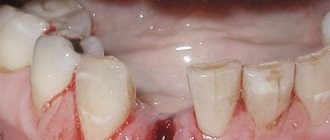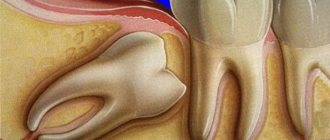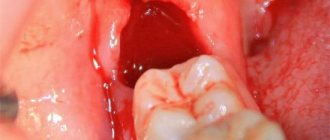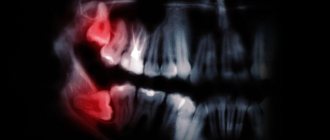Content:
- Symptoms of the disease
- How to understand that you need to remove the figure eight hood
- Preparing for surgery
- Progress of the operation to remove the tooth hood
- Rehabilitation period
Wisdom teeth often cause problems during eruption.
As it grows, the shell of gum tissue covering it begins to rise and loses its tightness. As a result, a gap is formed between the gum and the unit. Dentists call it the “hood.” Residues of food accumulate in it. It is not possible to remove them using normal hygiene procedures. Hence - an inflammatory process that is difficult to treat, a rapid spread of painful microflora in the mouth . The gum covering the “eight” swells, increases in size, and becomes painful to the touch. This inflammation in dentistry is called pericoronitis. It requires urgent dental care as it can lead to dangerous complications. In most cases, the patient is recommended to undergo a tooth hood removal procedure.
Complex extraction
The preparation stage here follows the same principle. A specialist is recommended to take an x-ray to determine root growth.
Is it painful to remove an upper wisdom tooth? After the anesthesia takes effect, the pain goes away and doctors begin surgery. It is carried out according to this scheme:
- the gum tissue is cut, after which it is peeled off from the bone;
- an area that is open (part or all of it) is cut out;
- The molar is removed, using an elevator or forceps;
- the hole is inspected to see if parts of the root remain;
- the wound is washed with antiseptic, anti-inflammatory solutions;
- the hole is stitched along the edges.
Symptoms of the disease
The problem does not manifest itself immediately. At first, when food debris has not yet accumulated under the soft tissues, there are no inflammatory symptoms. But later the disease manifests itself with the following symptoms:
- there is an unpleasant odor from the mouth;
- pain occurs in the area of inflammation;
- gums swell and often bleed.
If the wisdom tooth hood is not removed at this stage, the inflammatory reaction will begin to occur very quickly. Then the soft tissues surrounding the “eight” will become bright red, and pus will begin to ooze from the hood. While chewing food, the patient will experience unbearable pain. Due to severe discomfort, he will be forced to limit the mobility of the diseased jaw to the maximum.
The lymph nodes may also become involved in the inflammatory reaction. An increase in body temperature and the appearance of headaches are possible.
When a wisdom tooth is removed along with the hood
There are several reasons why only partial removal is ineffective. Among them, the first place in a kind of popularity ranking goes to insufficient free space.
In practice, this means that a massive tooth simply has nowhere to grow without cutting through the still healthy surrounding surfaces of varying degrees of hardness. If it has a problematic growth slope towards a neighboring tooth or even bone, then it is subject to emergency excision. After this, healing will not take long to occur.
In second place is the absence of other teeth adjacent to the third molar. Then preserving the problematic “tenant” does not have any practical benefit, because such a long distance is not suitable for reliable prosthetics.
Adding to the complexity is the fact that the formation of a hood is the prerogative of exclusively those wisdom teeth that have not yet been able to fully stick out. Because of this, a complex operation may take longer, and the recovery period may be longer than usual.
The reason for the delay is that there is simply no special scheme for accessing the problematic tooth from its socket using standard dental instruments. Here everything depends on the individual characteristics of each victim, which prompts the doctor to use a drill to divide the tooth into several parts. Only after this will it be possible to remove the cut parts from the alveolar process.
For such a long-term intervention, the dentist may use general anesthesia if he sees that his patient is on the verge of having a panic attack. The dentist will come to the same logical conclusion when he is faced with the irresistible gag reflex of his patient. This is explained by the fact that even the most careful master sometimes touches the patient’s tongue, which in some people provokes a strong vomiting reaction. To avoid traumatic situations, it is more productive to simply put a person into a stage of artificial sleep.
Contraindications for general anesthesia are only pregnancy in the first and last trimester.
The price of the service will depend entirely on what type of anesthesia was used, and whether anything else had to be removed other than the actual hood.
How to understand that you need to remove the figure eight hood
- Doctors insist on surgical treatment if:
- pus accumulates between the molar and gum;
- the pain is so severe that it is even difficult for a person to talk;
- signs of acute gingivitis appear, surrounding tissues are included in the pathological process;
- pain radiates to the temple, neck, lymph nodes;
- body temperature often rises.
All these symptoms indicate that the inflammation is very strong and measures need to be taken as soon as possible to eliminate it.
In what cases is removal justified?
Despite the popularity of such a service as wisdom tooth removal, there are not many real indications for this procedure:
- extensive damage to the tooth by caries (including generalized);
- serious deformation of the tooth or the impossibility of its treatment;
- incorrect position - the extreme molar can grow at an angle or even horizontally, simultaneously putting pressure on neighboring teeth, causing discomfort and pain;
- sometimes the wisdom tooth does not fit in the dental row and grows directly into the gum, causing severe pain;
- nerve damage, inflammation or cyst.
Incorrect position of the extreme molar can provoke changes in the bite and disruption of the dental system. As a result, the patient may develop diseases of the temporomandibular joints and masticatory muscles.
Preparing for surgery
You should not be afraid of dental hood removal surgery. It is performed under local anesthesia and does not cause serious discomfort to the patient. But for therapy to be successful, it is important to carefully prepare for it.
First, the doctor talks with the patient and listens to his complaints, finds out how long ago the inflammation occurred and how much it bothers him. Then he examines the oral cavity and palpates the inflamed area. Writes out a referral for radiography. Based on the diagnostic results, he decides whether the wisdom tooth can be saved.
A mandatory stage of preparation for surgery is taking blood tests for coagulation and some other indicators. If the inflammation is severe, the client may be prescribed antibiotics before surgery to stabilize the situation and create optimal conditions for excision of the overhanging hood.
If the doctor deems it necessary, he will first perform professional oral hygiene. During this procedure, he will remove accumulations of hard and soft dental plaque. This is necessary in order to reduce the likelihood of postoperative inflammation.
Extraction on the upper jaw
Is it painful to remove a wisdom tooth from above? There is less pain here, so the procedure is faster. This point can be explained by the fact that the upper jaw has its own structural characteristics. Bone density is less, it is characterized by plasticity. There is no curvature of the root; its growth is in the right direction. Nothing interferes with surgical intervention.
To extract a wisdom tooth, forceps or an elevator are used. However, there is a risk that the root will break. To avoid such a development of events, it is better to take an x-ray.
Progress of the operation to remove the tooth hood
When the treatment plan is drawn up, the patient has undergone the necessary preparation, and the operation is performed. It includes the following steps:
Introduction of anesthetic. The painkiller is selected on an individual basis. It is important that the patient is not allergic to it.- Excision of inflamed tissues hanging over the wisdom tooth. To do this, use a scalpel or special surgical scissors. The doctor carefully exposes the entire dental crown so that it can freely erupt to the end.
- Treatment of the resulting wound surface with an antiseptic. Removal of food debris and pus. After this, apply a turunda or compress with a wound-healing solution. It is needed to reduce the likelihood of pathogens entering the wound.
After the operation, the person can go home immediately. But on the appointed day he needs to appear for a second examination. Scheduled visits to a dental surgeon are required until the wound has completely healed.
How does the healing of an extracted tooth proceed?
Knowing what your gums should look like after wisdom tooth removal will help you track negative symptoms and consult a doctor in time to eliminate them. After 15-30 minutes, a blood clot with a bright burgundy color forms in the hole. It protects internal tissues from infection and promotes successful healing.
If there is no clot, they speak of “dry socket” syndrome - an undesirable complication that leads to suppuration of the wound. In this situation, the dentist will clean the hole and fill it with anti-inflammatory gel to avoid unpleasant consequences.
On the 3-4th day, the wound begins to become covered with a white film. Over the course of 2 weeks, the hole is covered with new epithelium and is visually indistinguishable from healthy gums. Bone structures are completely restored in 4-6 months.
Rehabilitation period
How long it will take for your gums to recover depends on many factors:
- volume of tissue removed;
- client age;
- individual characteristics of the patient’s body;
- correctness of the operation;
- accuracy of patient compliance with medical prescriptions.
To make rehabilitation as simple and fast as possible, you need to remember the rules:
- Do not eat for three hours after completion of surgical treatment.
- Remove the turunda (compress) only when the doctor tells you to. However, it should not be in the mouth for more than a day.
- Do not chew food on the same side of the jaw on which surgery was performed.
- Do not eat hot or very cold foods. The same goes for drinks.
- During hygiene procedures, do not touch the wound with a brush.
- Strictly take all medications prescribed by the dental surgeon.
- Do not self-medicate (it is unacceptable to try to speed up recovery using dubious folk methods).
If the patient listens to the advice of his doctor, the wound will heal quite quickly.
What is the difference between removing top and bottom eights?
Removing a tooth in the lower jaw is more difficult. The reason lies in the greater density of the alveolar process and the branching of the roots. When removing lower third molars, the risk of breaking off a root fragment increases, so the operation has certain specifics. To completely eliminate pain, conduction anesthesia is used here. In this case, the nerve through which the pain signal is transmitted is blocked for a long time. In the upper jaw, infiltration anesthesia, the so-called “freezing,” copes with the task of effective pain relief.
Tooth extraction: painful or not?
The popular idea of discomfort during the removal of a “wise” tooth is nothing more than a myth. Even the most complex dental operations are performed without the slightest pain, and painless removal of the third molar has long become the standard of an ordinary clinic.
The latest generation carpule anesthetics leave no chance for pain. The needle of a carpule syringe is thinner, so its insertion into the tissues of the oral cavity is almost not felt. To relieve sensitivity of the gums at the injection site, it is first lubricated with an anesthetic gel.
Particularly susceptible people experience psychological discomfort from the sounds of rocking a tooth with forceps. To eliminate stress, dentists use sedatives. Extraction with sedation allows the patient to relax in the dentist's chair and relieves anxiety.











